Need some cucumber inspiration? Try Japanese Cucumber Salad (Sunomono) that’s light, healthy, and incredibly refreshing! This sweet and sour cucumber salad with wakame seaweed makes a versatile side dish to serve with any Japanese meal.
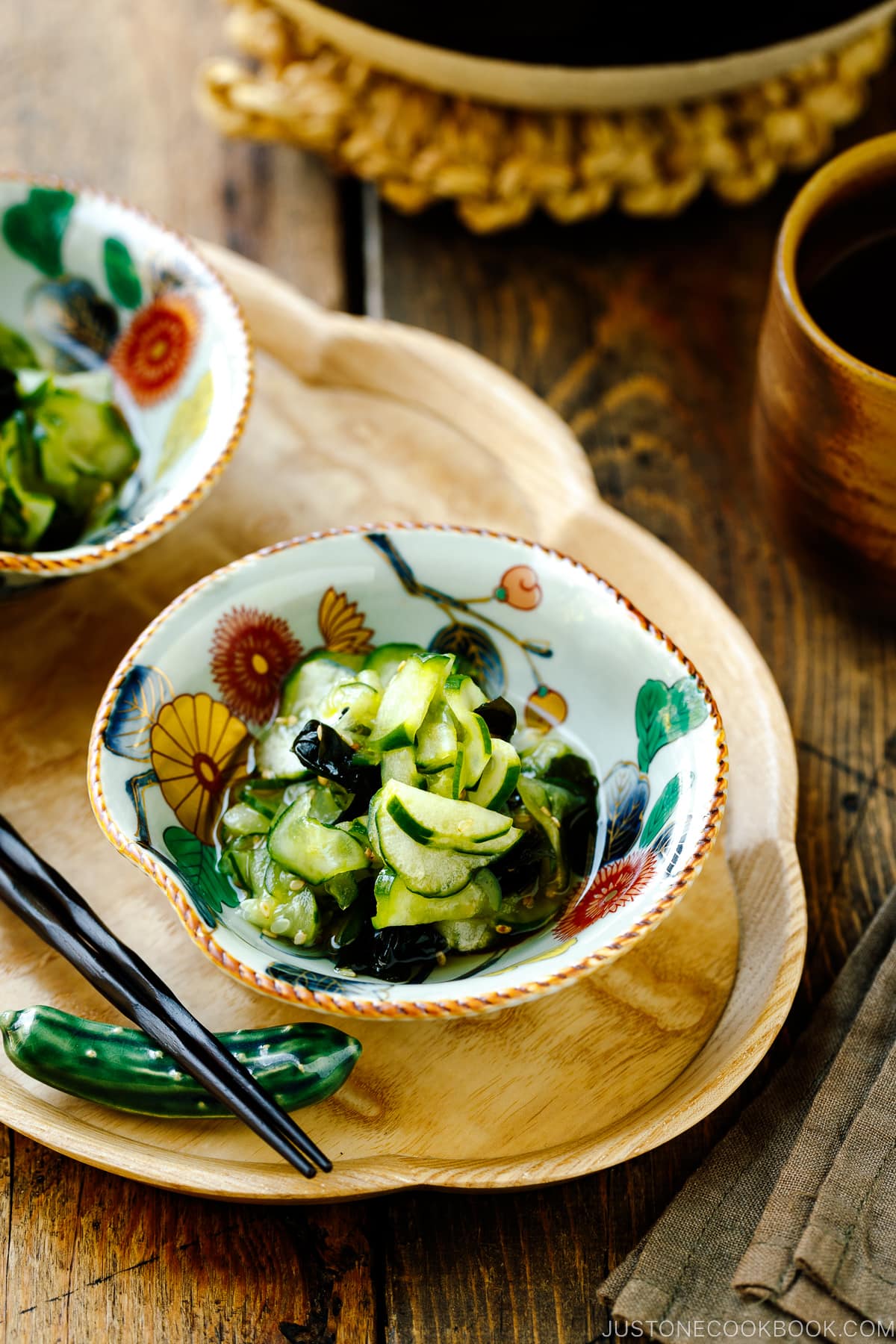
When cucumbers are at their peak in gardens and markets, we often find a few lingering around at the kitchen counter. If you are in need of some cucumber inspiration today, I hope you try this refreshing Japanese Cucumber Salad called Sunomono (酢の物). This is one of the most popular appetizers at the dinner table in Japan, and it’s simple and very easy to prepare in a short time.
Table of Contents
What is Sunomono?
Sunomono (酢の物) refers to vinegar-based dishes, and they are commonly served as a side dish to the main meal. These light refreshing vinegar salads are a great start to any meal as the sourness from the vinegar helps whet your appetite.
”Su (酢)” means vinegar in Japanese, and when we mention “sunomono,” it typically refers to Japanese cucumber salad. During the heat of summer and our bodies naturally gravitate towards ‘cooling’ food, this cucumber salad makes a wonderful seasonal side dish, especially for grilled fish or meat.
It is tangy, crunchy, and so easy to whip up. Plus, its health benefits are good enough reasons to enjoy on a weekly basis.
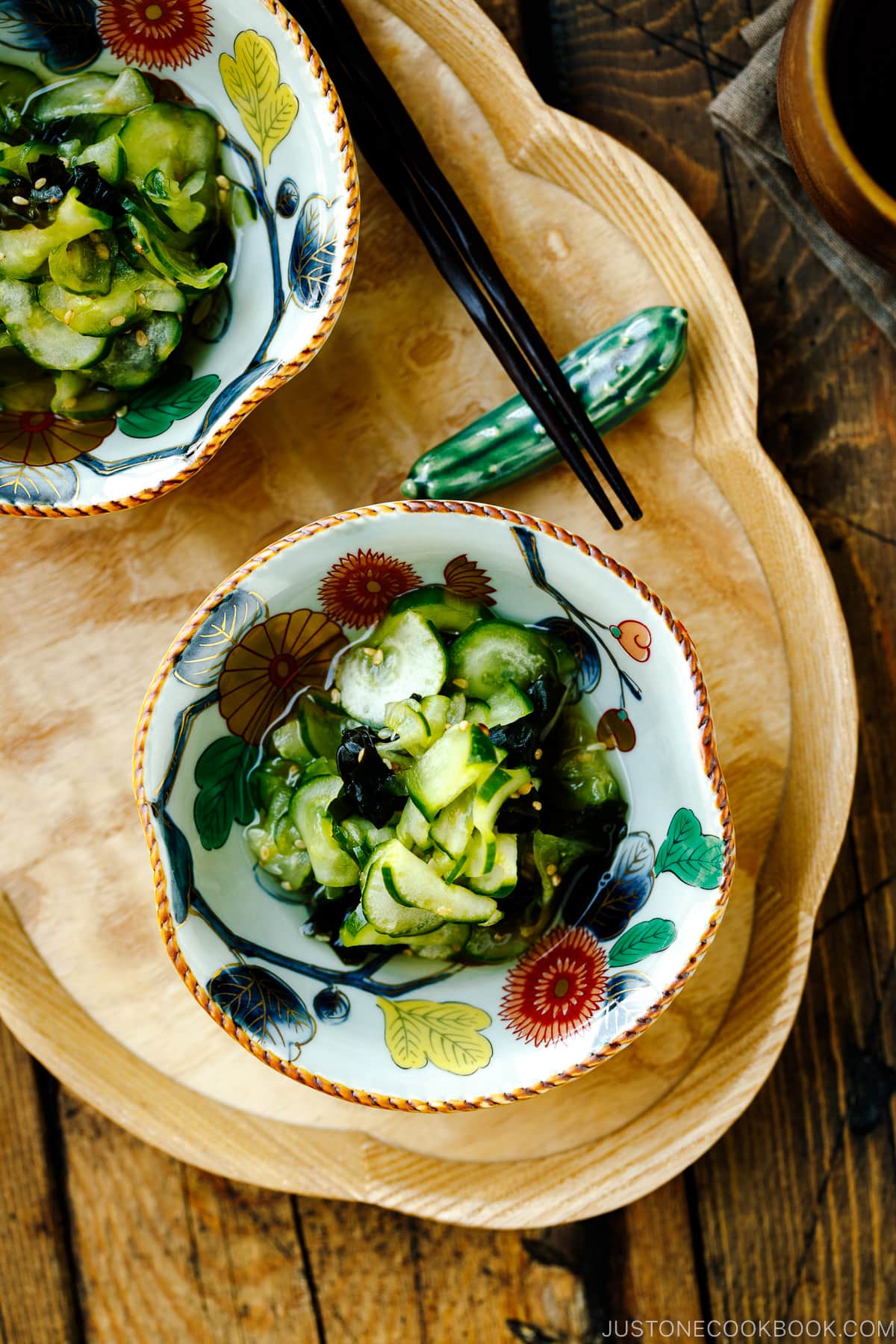
How to Make Japanese Cucumber Salad
The Ingredients You’ll Need
- Japanese or Persian cucumbers
- Dried wakame seaweed
- Toasted white sesame seeds
- Dressing: rice vinegar, soy sauce, sugar, and salt
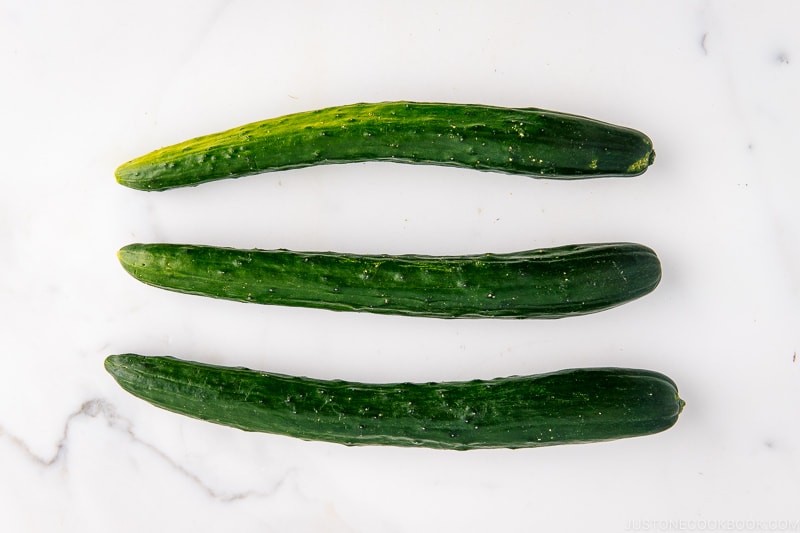
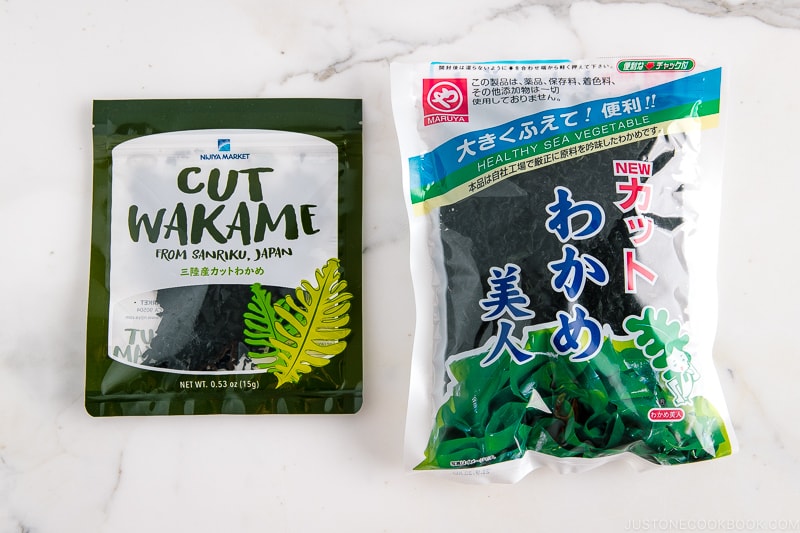
Substitutions
- Japanese cucumbers can be substituted with Persian cucumbers. Both of them don’t contain big seeds like American cucumbers. If you can’t find Japanese or Persian cucumbers, you can use an English cucumber, but scoop out the seeds with a spoon because seeds contain moisture that will dilute the dressing.
- You can skip dried wakame seaweed if you’re not a fan. You can read its health benefit in case you’re interested. Could’t find wakame seaweed? Try thinly sliced onion, radish, or carrots for a layer of texture and for additional nutrients.
The Cooking Steps
- Rehydrate dried wakame seaweed in water for 5 minutes.
- Cut the cucumbers into thin slices. Sprinkle the salt and distribute it evenly. Set aside for 5 minutes.
- Squeeze out the liquid from the rehydrated wakame seaweed and cucumbers.
- Make the dressing. Heat the dressing ingredients in a saucepan until the sugar is dissolved.
- Combine the well-drained seaweed and cucumber, sesame seeds, and dressing, and mix them all together. Serve and enjoy!
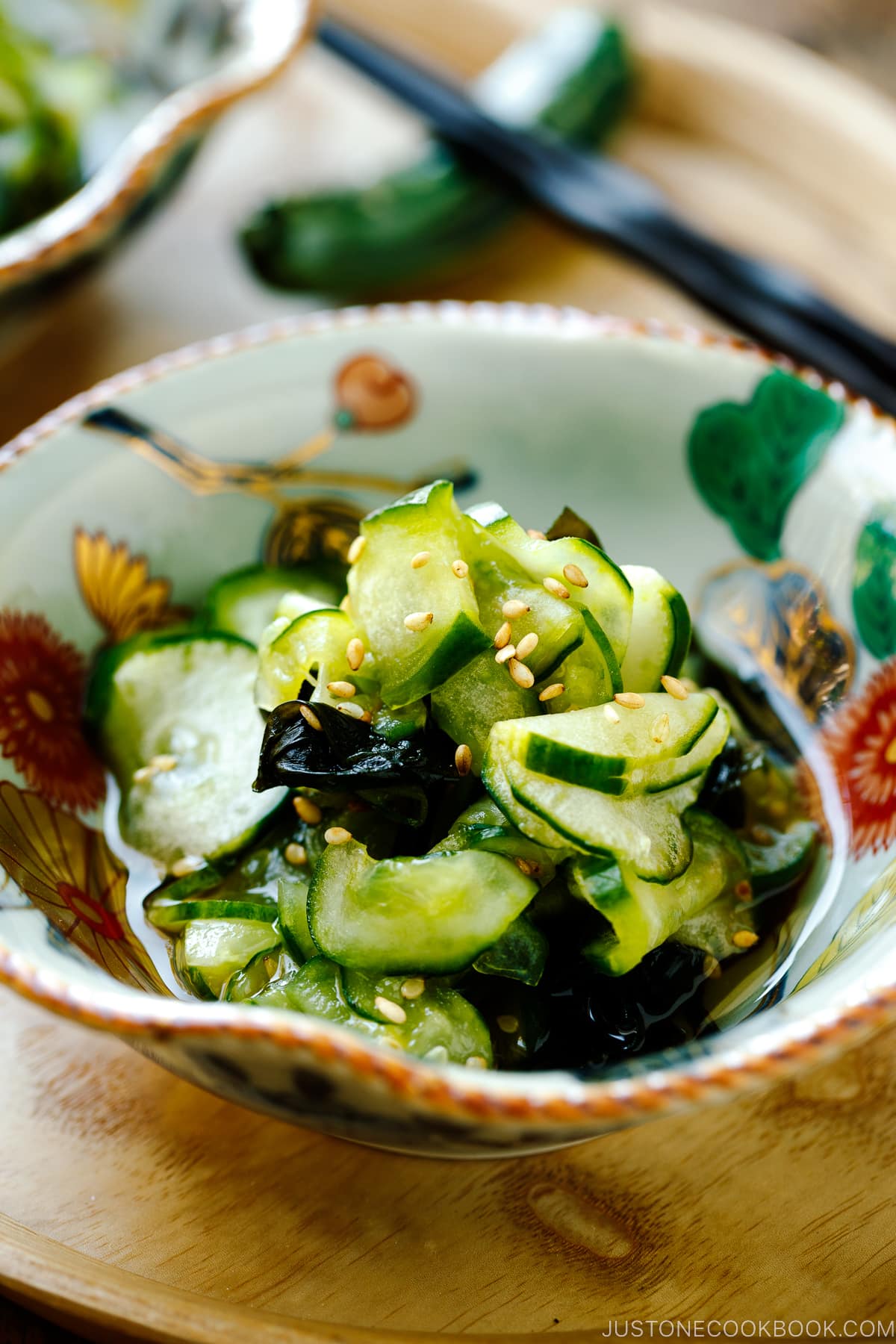
3 Cooking Tips
- Choose Japanese or Persian cucumbers. Avoid American cucumbers that contain big seeds and more moisture. Their skin is also waxy and thick, which is not ideal for this salad.
- Generously salt the cucumbers. The salt helps draw out the moisture from the cucumbers so it does not dilute the salad dressing after mixing. This ensures a great crunch for the salad.
- Squeeze out the liquid from the rehydrated wakame seaweed and cucumbers. If you don’t, the dressing will be diluted and the salad will have a bland taste.
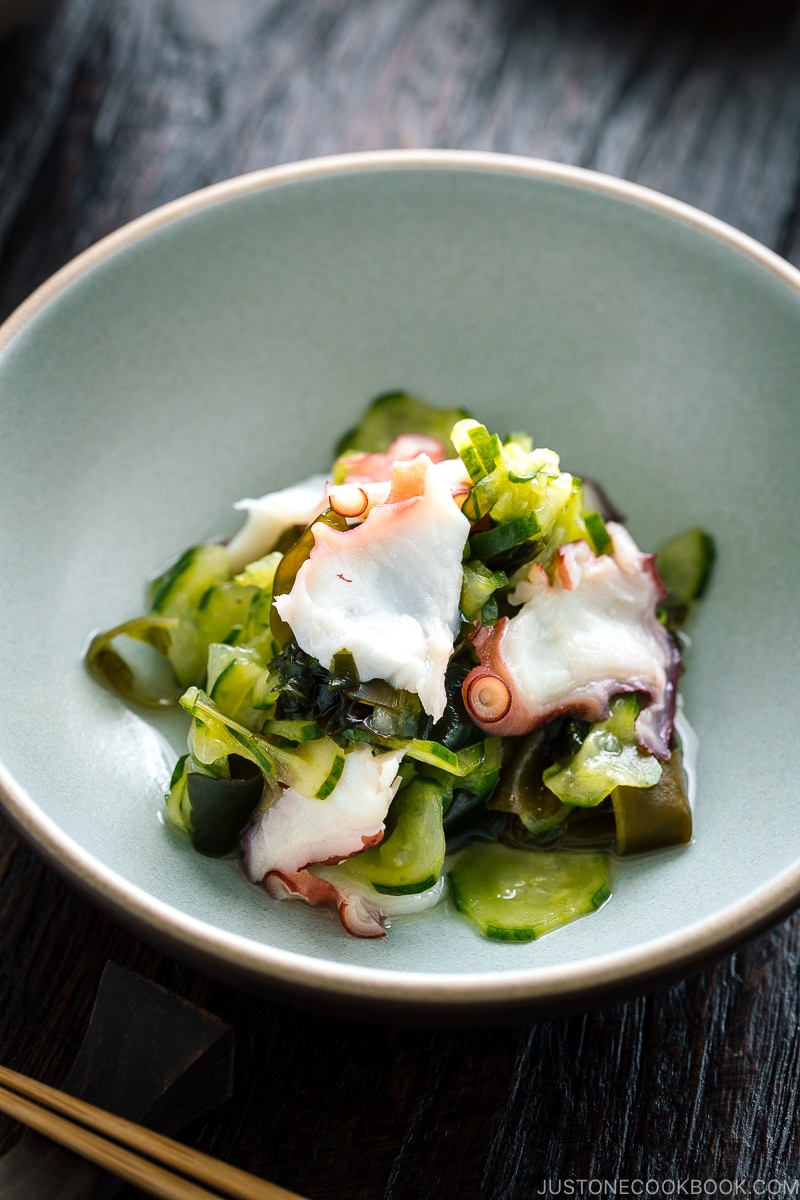
Non-Vegetarian Variations
The recipe below shows the basic method of making sunomono. You can easily change things up and make variations of the salad by adding the following:
- Crab meat – I am unfortunately allergic to crab, so I used imitation crab meat in this recipe. I have a variation of the recipe here.
- Boiled octopus – I buy boiled octopus from a Japanese grocery store. It’s sold in the sashimi section and the package usually says “octopus sashimi.” You just need to cut it into very thin slices. I have a variation of the recipe here.
- Shirasu (boiled baby anchovies) – Baby anchovies are commonly used in Japan, and they are rich in calcium. If you live by the ocean and have access to anchovies, you should give this a try!
- Ground sesame seeds to the dressing – I have a variation here that I used spiralized cucumbers.
Enjoy the perfect balance of sweet and sour in this delicious cucumber salad!
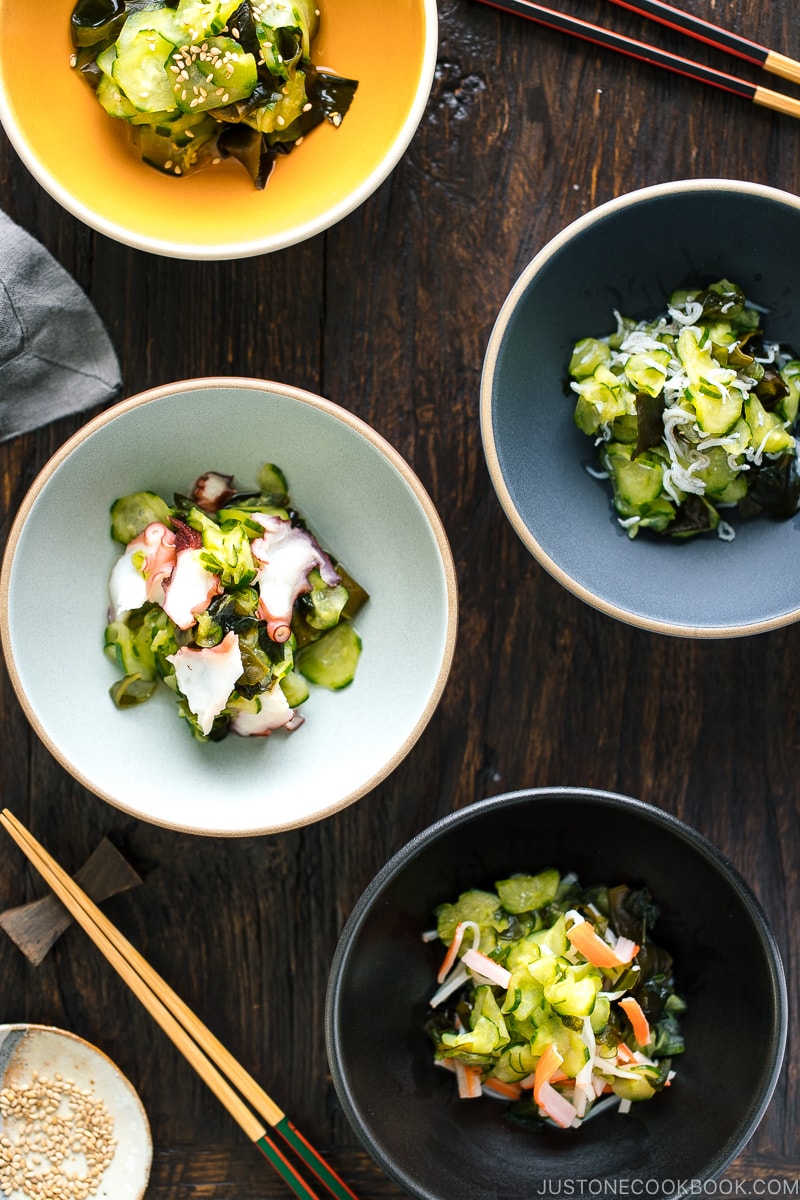
What to Serve with Japanese Cucumber Salad
- Main: Miso Cod, Baked Chicken Katsu, Simmered Beef and Tofu, Teriyaki Salmon.
- Sides: Spinach Ohitashi, Okra with Ginger Soy Sauce, Pickled Tomato,
- Rice: Japanese Mushroom Rice, Japanese Corn Rice, Takikomi Hijiki Gohan.
- Soup: Kabocha Miso Soup, Tonjiru (Pork and Vegetable Miso Soup), Cold Miso Soup.
If you want to check out other Japanese side dish recipes, read 15 Easy Japanese Side Dish Recipes.
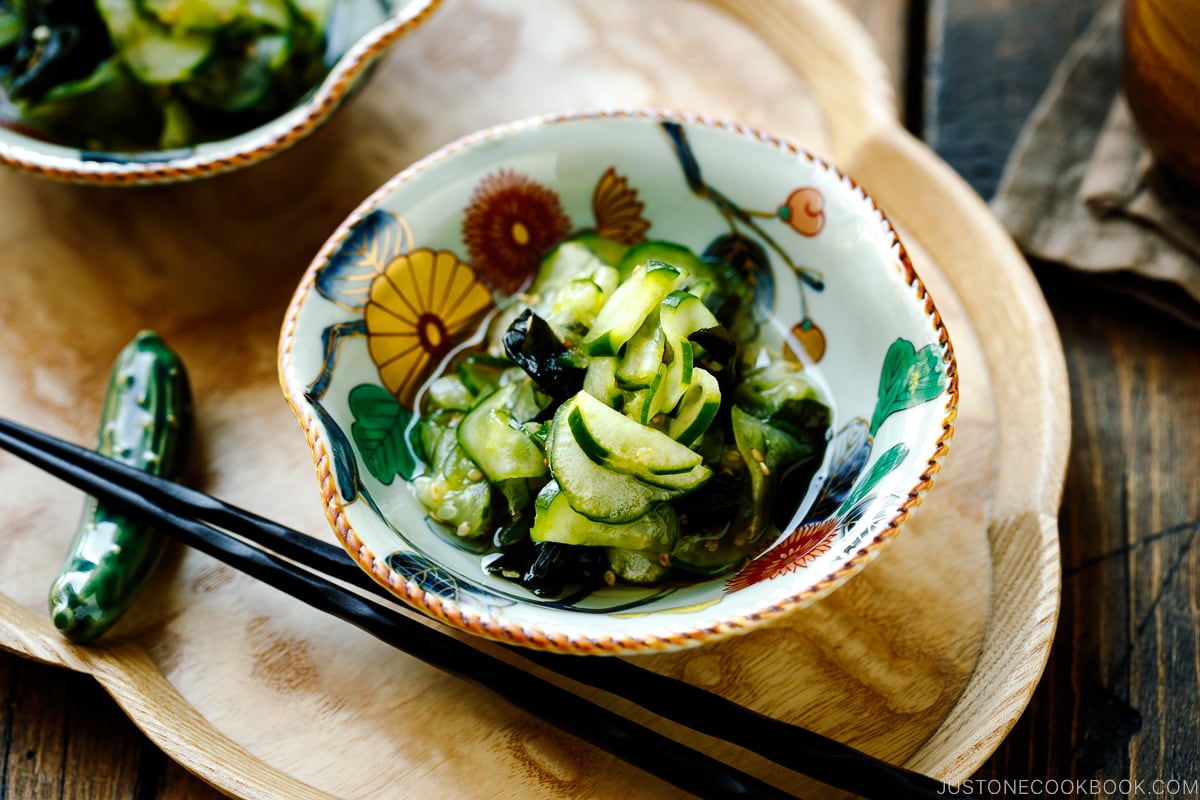
Wish to learn more about Japanese cooking? Sign up for our free newsletter to receive cooking tips & recipe updates! And stay in touch with me on Facebook, Pinterest, YouTube, and Instagram.
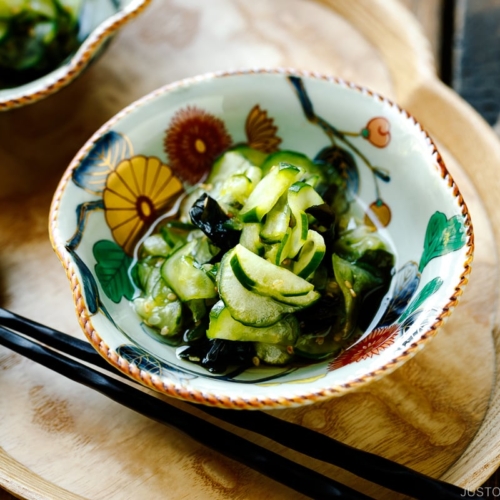
Japanese Cucumber Salad (Sunomono)
Video
Ingredients
For the Dressing
- 4 Tbsp rice vinegar (unseasoned)
- 2 Tbsp sugar
- ½ tsp Diamond Crystal kosher salt
- ½ tsp soy sauce (use GF soy sauce for gluten-free)
For the Sunomono
- 2 Japanese cucumbers (or 3 Persian cucumbers; 11 oz, 300 g)
- 1 tsp Diamond Crystal kosher salt
- 1 Tbsp dried wakame seaweed (3 g; 20–30 g after rehydration)
- ½ Tbsp toasted white sesame seeds
For the Variations (Optional)
- 4 pieces real or imitation crabmeat (skip for vegan/vegetarian)
- 2 oz octopus sashimi (boiled octopus) (skip for vegan/vegetarian)
- 2 Tbsp shirasu (boiled salted baby anchovies) (skip for vegan/vegetarian)
Instructions
- Gather all the ingredients.

To Make the Dressing
- In a saucepan, combine 4 Tbsp rice vinegar (unseasoned), 2 Tbsp sugar, ½ tsp Diamond Crystal kosher salt, and ½ tsp soy sauce.

- Heat over medium heat and whisk it well together. When the sugar is dissolved completely, remove the saucepan from the heat and let it cool. Tip: If you decrease the sugar amount (which I don't recommend), you may find that the vinegar tastes too strong. If it's still too strong for you after adding the cucumbers, you can dilute it with a very small amount of Dashi (Japanese soup stock), Vegan Dashi, or water.

To Make the Sunomono
- Soak 1 Tbsp dried wakame seaweed in water and let it rehydrate for 5 minutes.

- Meanwhile, peel the skin of 2 Japanese cucumbers, leaving some skin on to create stripes. Then, slice them thinly into rounds.

- Sprinkle 1 tsp Diamond Crystal kosher salt on the slices and gently massage it in. Set aside for 5 minutes. The salt helps draw out the moisture from the cucumbers (so it does not dilute the salad dressing after mixing).

- Squeeze out the liquid from the rehydrated wakame seaweed and add it to a medium bowl.

- Squeeze out the liquid from the cucumbers. and add them to the bowl. with the dressing and toss it all together.

- Add ½ Tbsp toasted white sesame seeds and pour the dressing.

- Combine everything together and serve in individual bowls or a large serving bowl.

Variations
- Crab meat: Cut 4 pieces real or imitation crabmeat into thirds. Add to the cucumber and wakame seaweed mixture in Step 7. Boiled octopus: Slice 2 oz octopus sashimi (boiled octopus) thinly. Add to the cucumber and wakame seaweed mixture in Step 7. Boiled salted baby anchovies: Add 2 Tbsp shirasu (boiled salted baby anchovies) to the cucumber and wakame seaweed mixture in Step 7.

To Store
- Keep in an airtight container and store in the refrigerator for up to 2–3 days (2 days for the seafood variations and 3 days for the classic version). However, the cucumber may release more moisture and the sauce may get diluted, so enjoy it soon!
Nutrition
Editor’s Note: This post was originally published on February 23, 2012. It was republished with a new video and images and more helpful information on September 22, 2023.
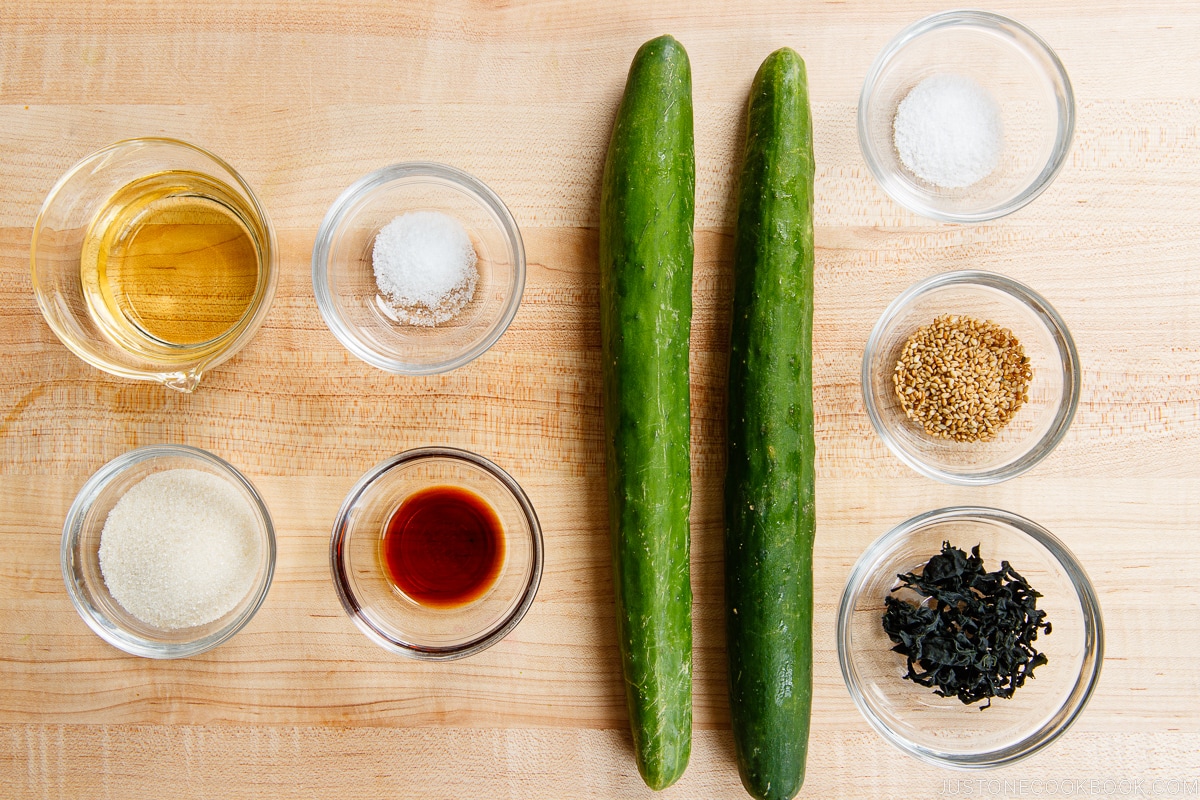
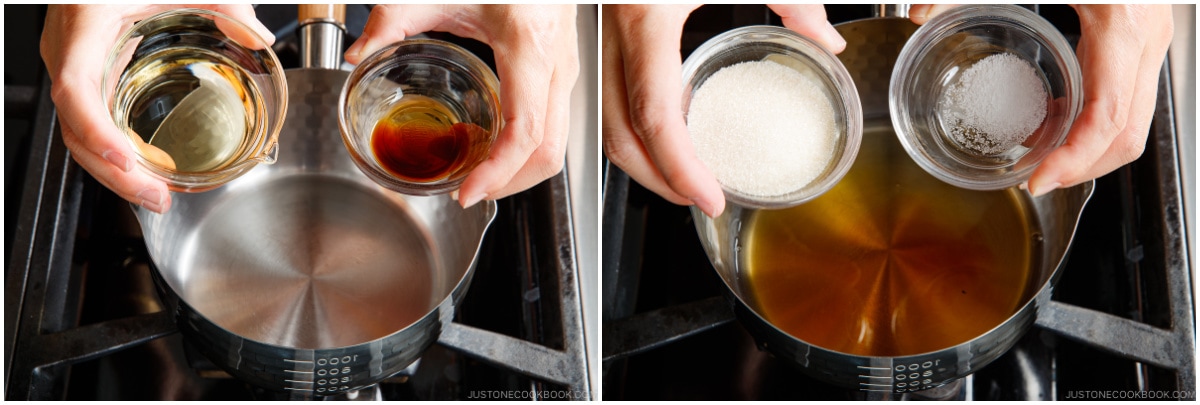
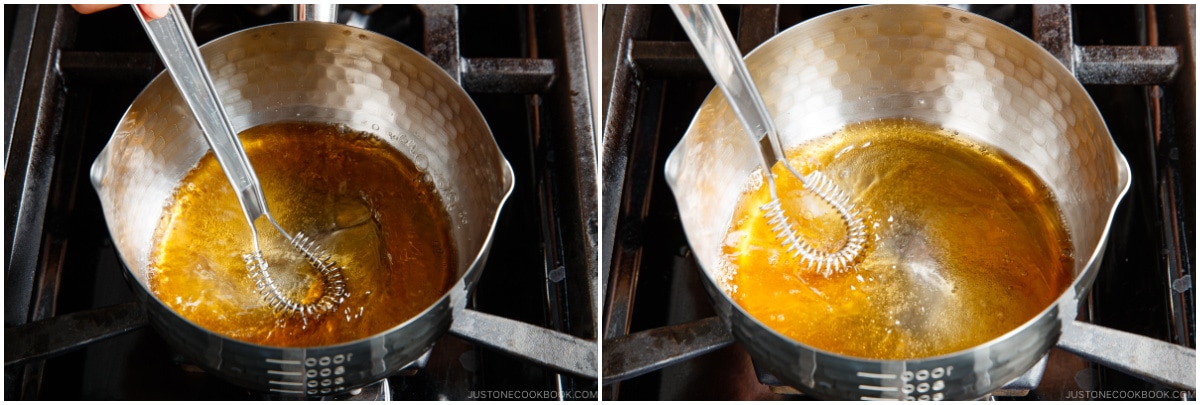
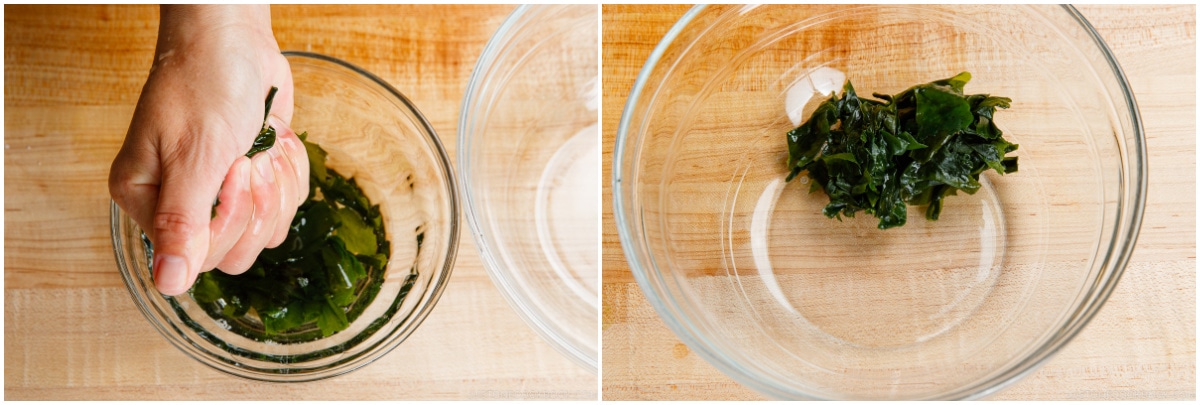
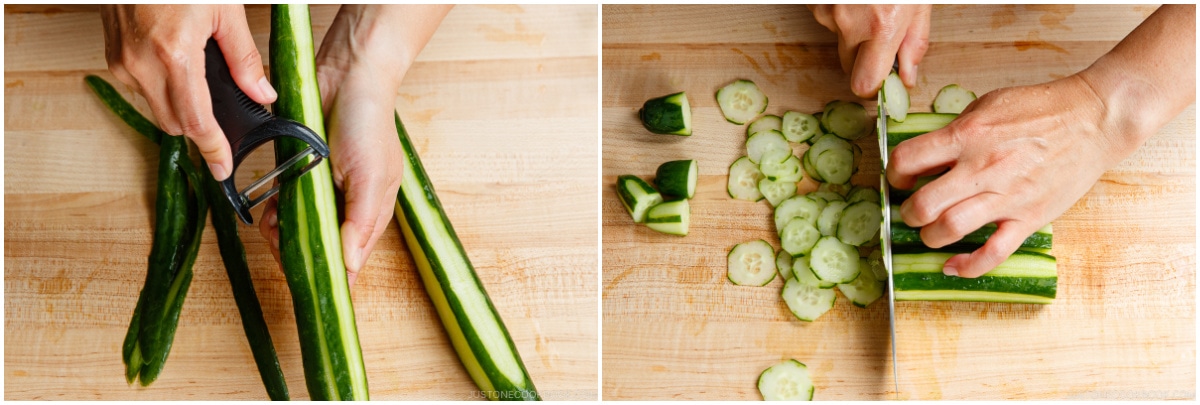
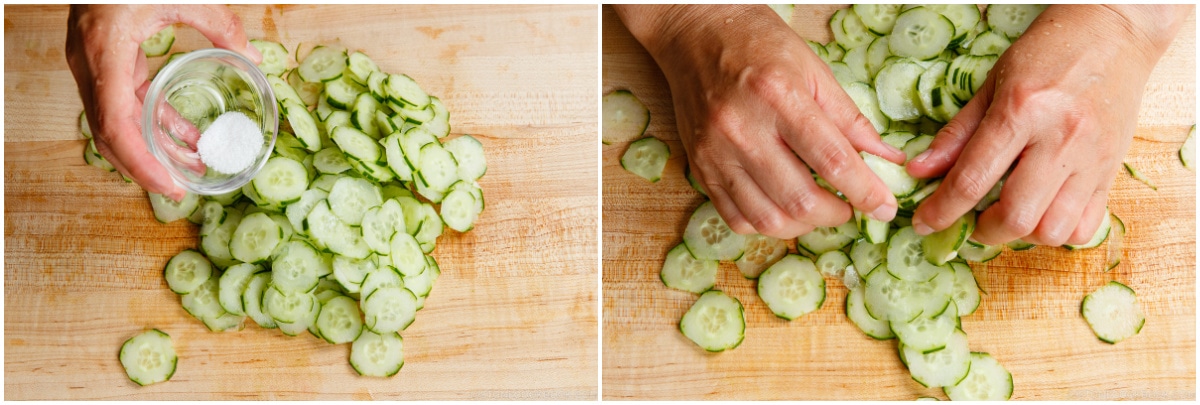
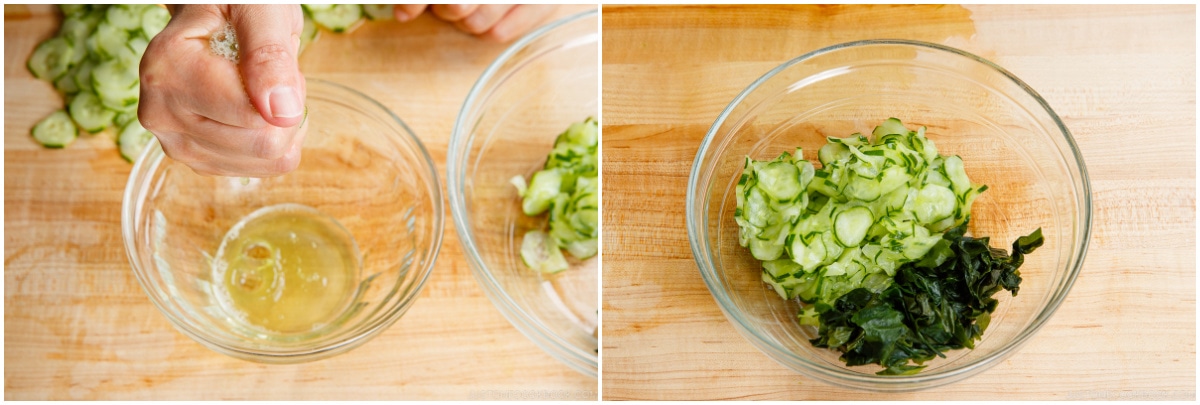
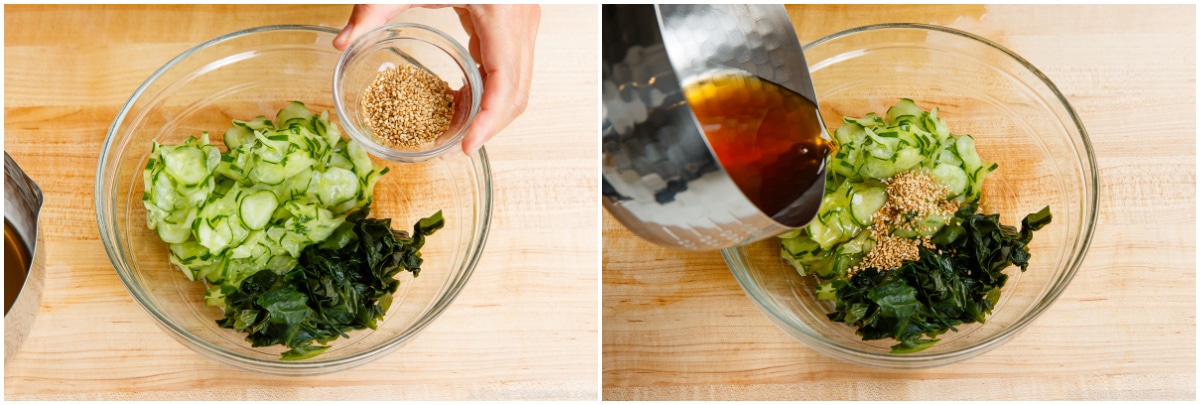
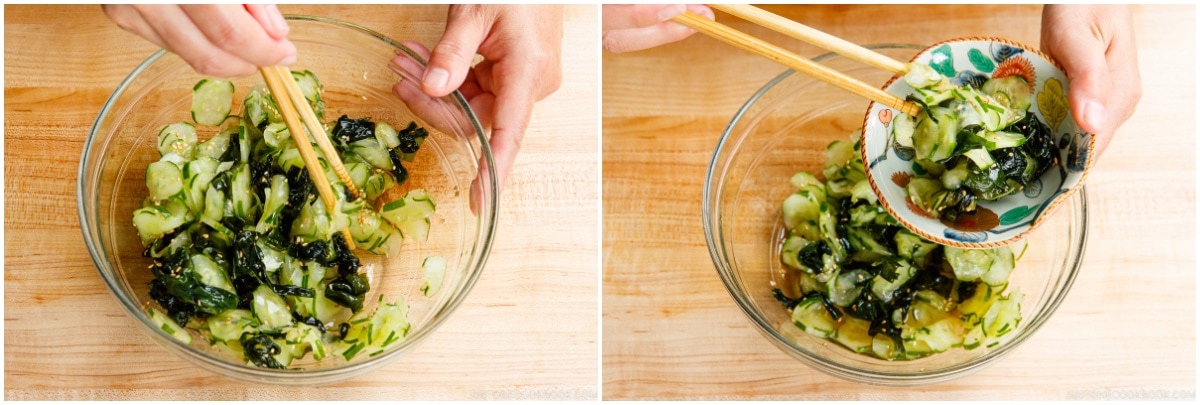
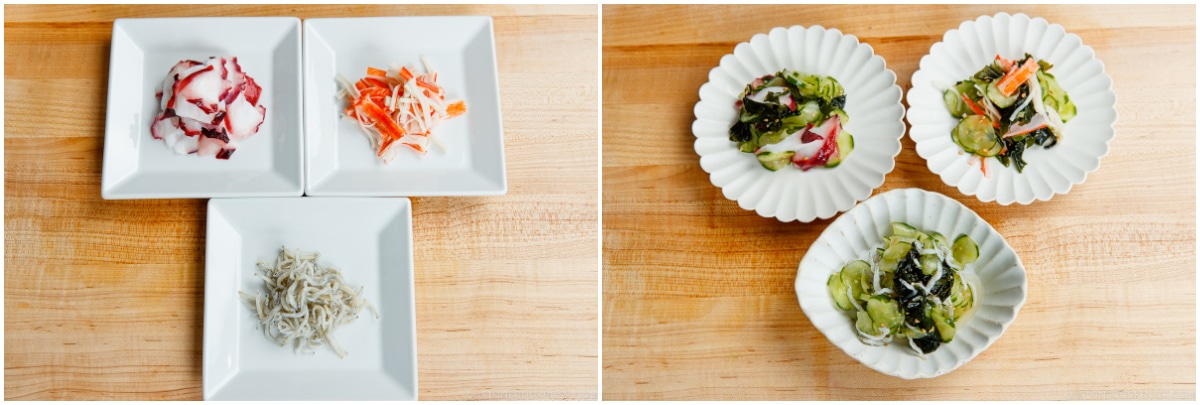


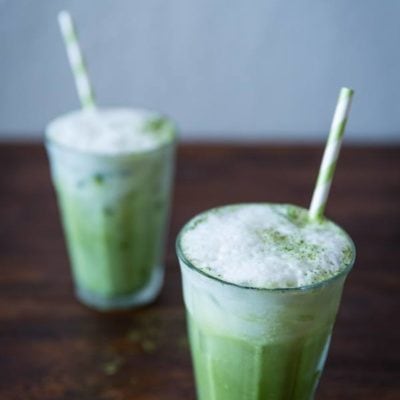

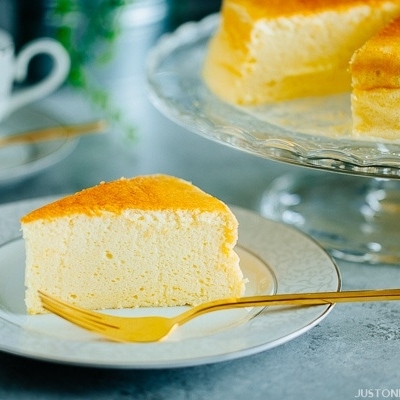

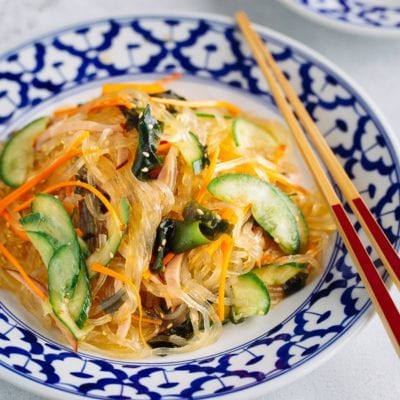

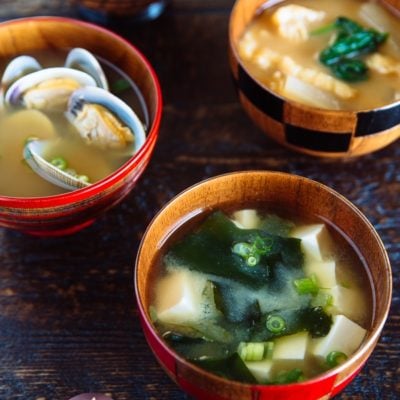

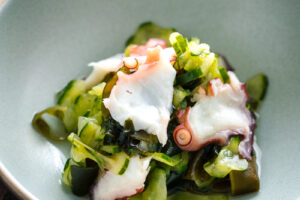
I didn’t read all the comments but I saw you mention about regular American cucumbers in the post itself. What many restaurants do who use American cucumbers are cut in half length-wise and scoop out the innards/seeds to decrease the moisture/water-issue, and then cut like normal.
We do the same thing when we make pickled cucumbers. Prevents too much liquid from coming out and it’s still yummy. 😊
Hi Laili! Yes, that’s definitely a trick you can use if you other types of cucumbers are not available. Thank you for sharing!
The American cucumber has a very thick and hard skin, while Persian or English cucumber has a very thin skin that is very similar to Japanese cucumber. So I still like to recommend English or Persian cucumber if there are those choices. 🙂
[…] Sunomono (Japanese Cucumber Salad) […]
[…] milder, and less acidic than western vinegars. It is an essential ingredient in sushi rice and sunomono (or sometimes called cucumber […]
[…] as “sour” as other kinds of vinegar. If you plan to make Sushi Rice (for making sushi), Cucumber Salad, and Japanese dressings, I highly recommend looking for rice […]
[…] Japanese Cucumber Salad from Just One Cookbook […]
Just here to say delicious recipe! I made it this week. I have a bottle of store-bought sunomono dressing from the Asian market but yours is much better. 😀
I used cucumber and octupus. It was very crisp and tangy and light, a perfect counter to rich creamy oyakodon. I used the leftovers along with bulgogi. <3
Hi Lion! I’m so happy you enjoyed this recipe. I can imagine your delicious meal… Thank you very much for your kind feedback. 🙂
Love them!!!
Thank you Gammy!
[…] Sunomono (Cucumber Salad) […]
How long can this last in the fridge, or should it all be eaten in one sitting?
Hi Justin! It varies on the ingredients you use, but 3-5 days should be okay in the fridge. 🙂
I made these tonight and could not stop eating them. They were SO good and so very easy! Thanks for the recipe Nami. 🙂
Hi Vicky! I’m so glad to hear that! Thanks so much for trying this recipe and for your kind feedback. 🙂
[…] Sunomono (Cucumber Salad) […]
This was way too sweet for me, so next time I’ll add less sugar. Loved it though, thanks for the recipe!
I also found this very sweet, and will reduce sugar next time. I love sunomono wiith sake! 🙂
Hi Rachael and Lord Sakana! Thank you for your feedback. Hope next one will turn out to be perfect. 🙂
Thanks for this beautiful recipe. The whole family liked it. I’ll definitely try out different variations soon. And since this is my first comment but this site has been my go-to-cook-book in all my endeavors of cooking Japanese for some time now, please let me add what the most astonishingly thing about it is: all the recipes work out at first try. This is really something and thanks to the tipps you add in. I could go on and rave about this site but I’ll keep recommending it to friends instead. Thank you very much.
Hi Sandra! Thank you so much for your kind words and I’m so happy your family enjoyed this recipe. I’m also glad to hear that you use my site to cook Japanese food too! Thank you for sharing my site with your friends. It means SO MUCH to us. Thank you thank you!!! xoxo
Hi T! The vermicelli noodles sometimes included in this salad is called Harusame. I have the preparation in this post, and you can use it to add this recipe but I’d increase the dressing slightly since the noodles will absorb some. 🙂
Made it so often. it’s just Perfect!
Hi Bianca! Thank you for your kind feedback!